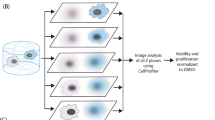Abstract
Cancer cells from cell lines and tumor biopsy tissue undergo aggregation and aggregate coalescence when dispersed in a 3D Matrigel™ matrix. Coalescence is a dynamic process mediated by a subset of cells within the population of cancer cells. In contrast, non-tumorigenic cells from normal cell lines and normal tissues do not aggregate or coalesce, nor do they possess the motile cell types that orchestrate coalescence of cancer cells. Therefore, coalescence is a cancer cell-specific phenotype that may drive tumor growth in vivo, especially in cases of field cancerization. Here, we describe a simple 3D tumorigenesis model that takes advantage of the coalescence capabilities of cancer cells and uses this feature as the basis for a screen for treatments that inhibit tumorigenesis. The screen is especially useful in testing monoclonal antibodies that target cell-cell interactions, cell-matrix interactions, cell adhesion molecules, cell surface receptors, and general cell surface markers. The model can also be used for 2D imaging in a 96-well plate for rapid screening and is adaptable for 3D high-resolution assessment. In the latter case, we show how the 3D model can be optically sectioned with differential interference contrast (DIC) optics, then reconstructed in 4D and quantitatively analyzed by computer-assisted methods, or, alternatively, imaged with confocal microscopy for 4D quantitative analysis of cancer cell interactions with normal cells within the tumor microenvironment. We demonstrate reconstructions and quantitative analyses using the advanced image analysis software J3D-DIAS 4.2, in order to illustrate the types of detailed phenotypic characterizations that have proven useful. Other software packages may be able to perform similar types of analyses.
Access this chapter
Tax calculation will be finalised at checkout
Purchases are for personal use only
Similar content being viewed by others
References
Ambrose J, Livitz M, Wessels D, Kuhl S, Lusche DF, Scherer A, Voss E, Soll DR (2015) Mediated coalescence: a possible mechanism for tumor cellular heterogeneity. Am J Cancer Res 5(11):3485–3504
Scherer A, Kuhl S, Wessels D, Lusche DF, Hanson B, Ambrose J, Voss E, Fletcher E, Goldman C, Soll DR (2015) A computer-assisted 3D model for analyzing the aggregation of tumorigenic cells reveals specialized behaviors and unique cell types that facilitate aggregate coalescence. PLoS One 10(3):e0118628. https://doi.org/10.1371/journal.pone.0118628
Wessels D, Lusche DF, Voss E, Kuhl S, Buchele EC, Klemme MR, Russell KB, Ambrose J, Soll BA, Bossler A, Milhem M, Goldman C, Soll DR (2017) Melanoma cells undergo aggressive coalescence in a 3D Matrigel model that is repressed by anti-CD44. PLoS One 12(3):e0173400. https://doi.org/10.1371/journal.pone.0173400
Lusche DF, Klemme MR, Soll BA, Reis RJ, Forrest CC, Nop TS, Wessels DJ, Berger B, Glover R, Soll DR (2019) Integrin α-3 ß-1’s central role in breast cancer, melanoma and glioblastoma cell aggregation revealed by antibodies with blocking activity. mAbs:null-null. https://doi.org/10.1080/19420862.2019.1583987
Hughes CS, Postovit LM, Lajoie GA (2010) Matrigel: a complex protein mixture required for optimal growth of cell culture. Proteomics 10(9):1886–1890. https://doi.org/10.1002/pmic.200900758
Heaphy CM, Griffith JK, Bisoffi M (2009) Mammary field cancerization: molecular evidence and clinical importance. Breast Cancer Res Treat 118(2):229–239. https://doi.org/10.1007/s10549-009-0504-0
Slaughter DP, Southwick HW, Smejkal W (1953) Field cancerization in oral stratified squamous epithelium; clinical implications of multicentric origin. Cancer 6(5):963–968
Wessels DJ, Pradhan N, Park YN, Klepitsch MA, Lusche DF, Daniels KJ, Conway KD, Voss ER, Hegde SV, Conway TP, Soll DR (2019) Reciprocal signaling and direct physical interactions between fibroblasts and breast cancer cells in a 3D environment. PLoS One 14(6):e0218854. https://doi.org/10.1371/journal.pone.0218854
Kuhl S, Voss E, Scherer A, Lusche DF, Wessels D, Soll DR (2016) 4D Tumorigenesis model for quantitating coalescence, quantitating directed cell motility and chemotaxis, identifying unique cell behaviors and testing anti-cancer drugs. In: Hereld D, Jin T (eds) Chemotaxis: methods and protocols. Springer
Soll DR, Voss E, Johnson O, Wessels D (2000) Three-dimensional reconstruction and motion analysis of living, crawling cells. Scanning 22(4):249–257
Soll DR, Wessels D, Heid PJ, Voss E (2003) Computer-assisted reconstruction and motion analysis of the three-dimensional cell. Scientific World Journal 3(Journal Article):827–841. https://doi.org/10.1100/tsw.2003.70
Wessels DJ, Lusche DF, Kuhl S, Scherer A, Voss E, Soll DR (2016) Quantitative motion analysis in two and three dimensions. Methods in molecular biology 1365:265–292. https://doi.org/10.1007/978-1-4939-3124-8_14
Kaur DK, V. (2014) Various image segmentation techniques: a review. Int J Comput Sci Mob Comput 3(5):809–814
Lorensen WE, Cline HE (1987) Marching cubes: a high resolution 3D surface construction algorithm. ACM SIGGRAPH Comput Graph 21:163–169
Maron MJ (1982) Numerical analysis. New York: Macmillan Publishers
Dixit R, Cyr R (2003) Cell damage and reactive oxygen species production induced by fluorescence microscopy: effect on mitosis and guidelines for non-invasive fluorescence microscopy. Plant J 36(2):280–290
Schneider CA, Rasband WS, Eliceiri KW (2012) NIH Image to ImageJ: 25 years of image analysis. Nat Methods 9(7):671–675
Acknowledgments
These studies were supported by the Developmental Studies Hybridoma Bank (DSHB), a National Resource created by NIH and housed at the University of Iowa.
The monoclonal antibodies AIIB2 and H4C4 were obtained from the DSHB. AIIB2 was developed by C.H. Damsky. H4C4 was developed by J.T. August and J.E.K. Hildreth.
Author information
Authors and Affiliations
Corresponding author
Editor information
Editors and Affiliations
Rights and permissions
Copyright information
© 2022 The Author(s), under exclusive license to Springer Science+Business Media, LLC, part of Springer Nature
About this protocol
Cite this protocol
Wessels, D., Lusche, D.F., Voss, E., Soll, D.R. (2022). 3D and 4D Tumorigenesis Model for the Quantitative Analysis of Cancer Cell Behavior and Screening for Anticancer Drugs. In: Gavin, R.H. (eds) Cytoskeleton . Methods in Molecular Biology, vol 2364. Humana, New York, NY. https://doi.org/10.1007/978-1-0716-1661-1_14
Download citation
DOI: https://doi.org/10.1007/978-1-0716-1661-1_14
Published:
Publisher Name: Humana, New York, NY
Print ISBN: 978-1-0716-1660-4
Online ISBN: 978-1-0716-1661-1
eBook Packages: Springer Protocols




